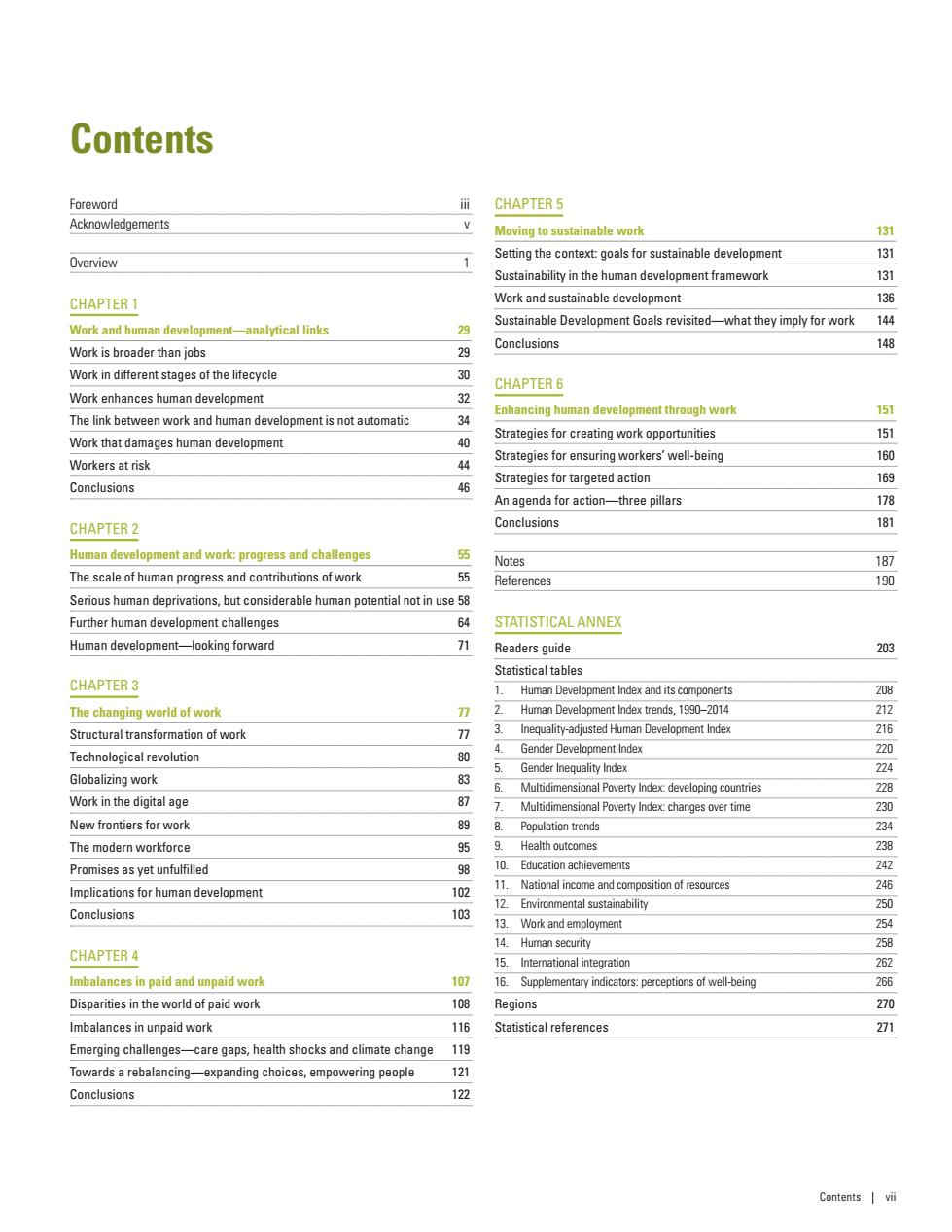正在加载图片...

Contents Foreword CHAPTER 5 Acknowledgements Moving to sustainable work 131 Setting the context:goals for sustainable development 131 Overview Sustainability in the human development framework 131 CHAPTER 1 Work and sustainable development 136 Sustainable Development Goals revisited-what they imply for work Work and human development-analytical links 144 29 Conclusions 148 Work is broader than jobs 29 Work in different stages of the lifecycle 30 CHAPTER 6 Work enhances human development 32 Enhancing human development through work 151 The link between work and human development is not automatic 34 Strategies for creating work opportunities 151 Work that damages human development 40 Strategies for ensuring workers'well-being 160 Workers at risk 44 Strategies for targeted action 169 Conclusions 46 An agenda for action-three pillars 178 CHAPTER 2 Conclusions 181 Human development and work:progress and challenges 的 Notes 187 The scale of human progress and contributions of work 55 References 190 Serious human deprivations,but considerable human potential not in use 58 Further human development challenges 64 STATISTICAL ANNEX Human development-looking forward 71 Readers guide 203 Statistical tables CHAPTER 3 1.Human Development Index and its components 208 The changing world of work 77 2.Human Development Index trends,1990-2014 212 Structural transformation of work 公 3.Inequality-adiusted Human Development Index 216 4. Technological revolution 80 Gender Development Index 220 5. Gender Inequality Index 224 Globalizing work 83 6. Multidimensional Poverty Index:developing countries 228 Work in the digital age 吗 7. Multidimensional Poverty Index:changes over time 230 New frontiers for work 89 8. Population trends 234 The modern workforce 95 9. Health outcomes 238 Promises as yet unfulfilled 98 10.Education achievements 242 Implications for human development 102 11.National income and composition of resources 246 12.Environmental sustainability 250 Conclusions 103 13.Work and employment 254 14.Human security 258 CHAPTER 4 15.International integration 262 Imbalances in paid and unpaid work 107 16.Supplementary indicators:perceptions of well-being 266 Disparities in the world of paid work 108 Regions 270 Imbalances in unpaid work 116 Statistical references 271 Emerging challenges-care gaps,health shocks and climate change 119 Towards a rebalancing-expanding choices,empowering people 121 Conclusions 122 Contents viiContents Foreword iii Acknowledgements v Overview 1 CHAPTER 1 Work and human development—analytical links 29 Work is broader than jobs 29 Work in different stages of the lifecycle 30 Work enhances human development 32 The link between work and human development is not automatic 34 Work that damages human development 40 Workers at risk 44 Conclusions 46 CHAPTER 2 Human development and work: progress and challenges 55 The scale of human progress and contributions of work 55 Serious human deprivations, but considerable human potential not in use 58 Further human development challenges 64 Human development—looking forward 71 CHAPTER 3 The changing world of work 77 Structural transformation of work 77 Technological revolution 80 Globalizing work 83 Work in the digital age 87 New frontiers for work 89 The modern workforce 95 Promises as yet unfulfilled 98 Implications for human development 102 Conclusions 103 CHAPTER 4 Imbalances in paid and unpaid work 107 Disparities in the world of paid work 108 Imbalances in unpaid work 116 Emerging challenges—care gaps, health shocks and climate change 119 Towards a rebalancing—expanding choices, empowering people 121 Conclusions 122 CHAPTER 5 Moving to sustainable work 131 Setting the context: goals for sustainable development 131 Sustainability in the human development framework 131 Work and sustainable development 136 Sustainable Development Goals revisited—what they imply for work 144 Conclusions 148 CHAPTER 6 Enhancing human development through work 151 Strategies for creating work opportunities 151 Strategies for ensuring workers’ well-being 160 Strategies for targeted action 169 An agenda for action—three pillars 178 Conclusions 181 Notes 187 References 190 STATISTICAL ANNEX Readers guide 203 Statistical tables 1. Human Development Index and its components 208 2. Human Development Index trends, 1990–2014 212 3. Inequality-adjusted Human Development Index 216 4. Gender Development Index 220 5. Gender Inequality Index 224 6. Multidimensional Poverty Index: developing countries 228 7. Multidimensional Poverty Index: changes over time 230 8. Population trends 234 9. Health outcomes 238 10. Education achievements 242 11. National income and composition of resources 246 12. Environmental sustainability 250 13. Work and employment 254 14. Human security 258 15. International integration 262 16. Supplementary indicators: perceptions of well-being 266 Regions 270 Statistical references 271 Contents | vii